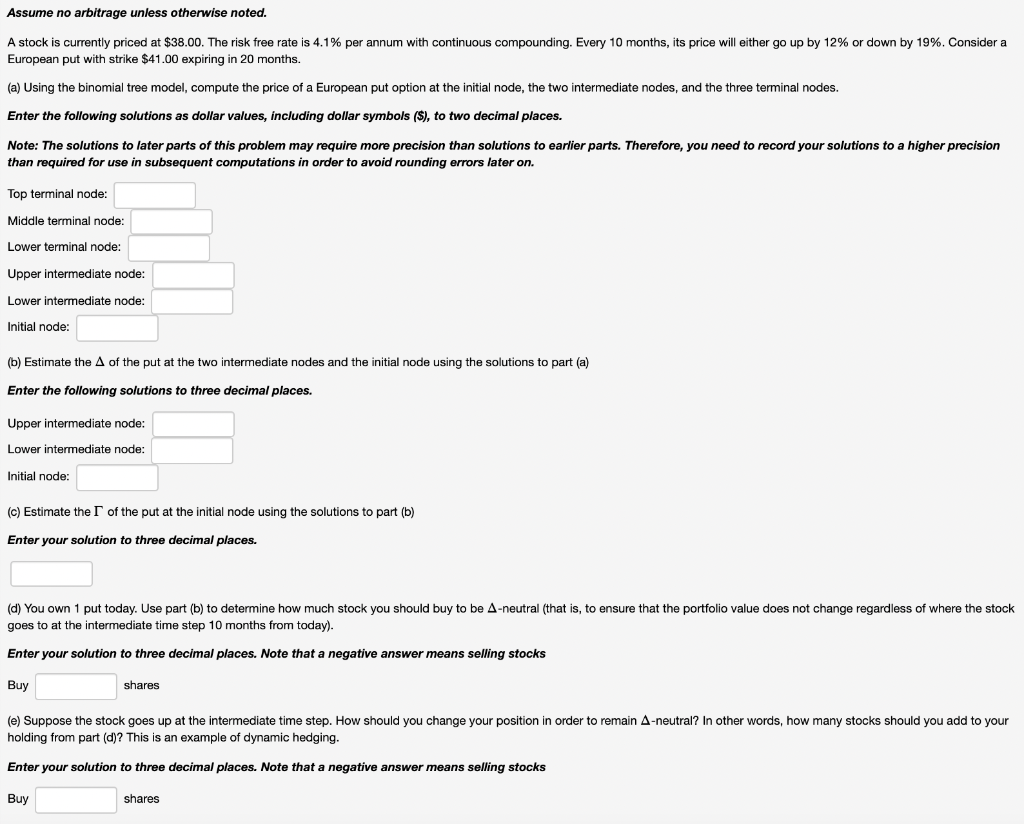
Assume no arbitrage unless otherwise noted. A stock is currently priced at $38.00. The risk free rate is 4.1% per annum with continuous compounding. Every 10 months, its price will either go up by 12% or down by 19%. Consider a European put with strike $41.00 expiring in 20 months. (a) Using the binomial tree model, compute the price of a European put option at the initial node, the two intermediate nodes, and the three terminal nodes. Enter the following solutions as dollar values, including dollar symbols ($), to two decimal places. Note: The solutions to later parts of this problem may require more precision than solutions to earlier parts. Therefore, you need to record your solutions to a higher precision than required for use in subsequent computations in order to avoid rounding errors later on. Top terminal node: Middle terminal node: Lower terminal node: Upper intermediate node: Lower intermediate node: Initial node: (b) Estimate the A of the put at the two intermediate nodes and the initial node using the solutions to part (a) Enter the following solutions to three decimal places. Upper intermediate node: Lower intermediate node: Initial node: (c) Estimate the l of the put at the initial node using the solutions to part (b) Enter your solution to three decimal places. (d) You own 1 put today. Use part (b) to determine how much stock you should buy to be A-neutral (that is, to ensure that the portfolio value does not change regardless of where the stock goes to at the intermediate time step 10 months from today). Enter your solution to three decimal places. Note that a negative answer means selling stocks Buy shares (e) Suppose the stock goes up at the intermediate time step. How should you change your position in order to remain A-neutral? In other words, how many stocks should you add to your holding from part (d)? This is an example of dynamic hedging. Enter your solution to three decimal places. Note that a negative answer means selling stocks Buy shares Assume no arbitrage unless otherwise noted. A stock is currently priced at $38.00. The risk free rate is 4.1% per annum with continuous compounding. Every 10 months, its price will either go up by 12% or down by 19%. Consider a European put with strike $41.00 expiring in 20 months. (a) Using the binomial tree model, compute the price of a European put option at the initial node, the two intermediate nodes, and the three terminal nodes. Enter the following solutions as dollar values, including dollar symbols ($), to two decimal places. Note: The solutions to later parts of this problem may require more precision than solutions to earlier parts. Therefore, you need to record your solutions to a higher precision than required for use in subsequent computations in order to avoid rounding errors later on. Top terminal node: Middle terminal node: Lower terminal node: Upper intermediate node: Lower intermediate node: Initial node: (b) Estimate the A of the put at the two intermediate nodes and the initial node using the solutions to part (a) Enter the following solutions to three decimal places. Upper intermediate node: Lower intermediate node: Initial node: (c) Estimate the l of the put at the initial node using the solutions to part (b) Enter your solution to three decimal places. (d) You own 1 put today. Use part (b) to determine how much stock you should buy to be A-neutral (that is, to ensure that the portfolio value does not change regardless of where the stock goes to at the intermediate time step 10 months from today). Enter your solution to three decimal places. Note that a negative answer means selling stocks Buy shares (e) Suppose the stock goes up at the intermediate time step. How should you change your position in order to remain A-neutral? In other words, how many stocks should you add to your holding from part (d)? This is an example of dynamic hedging. Enter your solution to three decimal places. Note that a negative answer means selling stocks Buy shares







